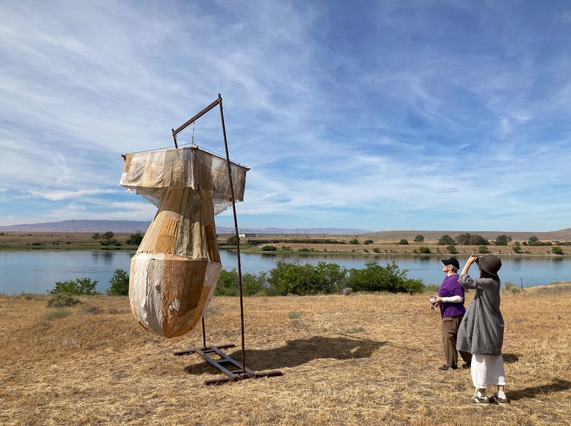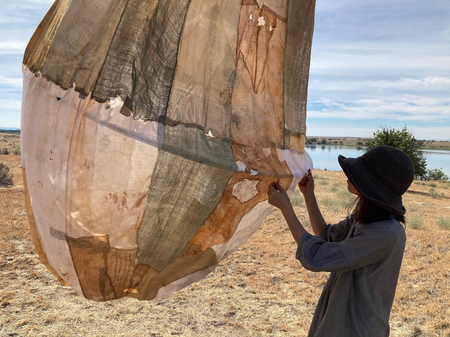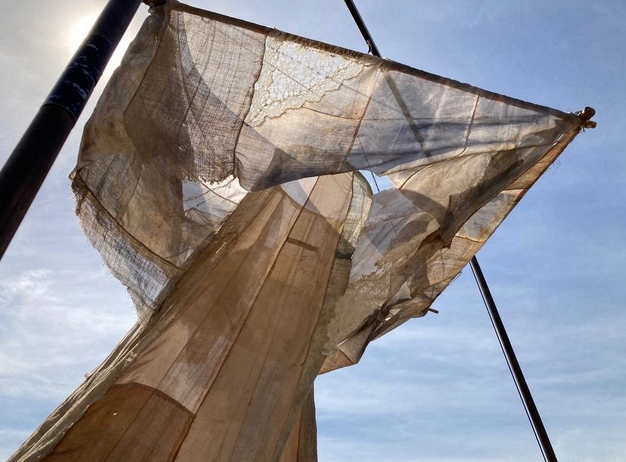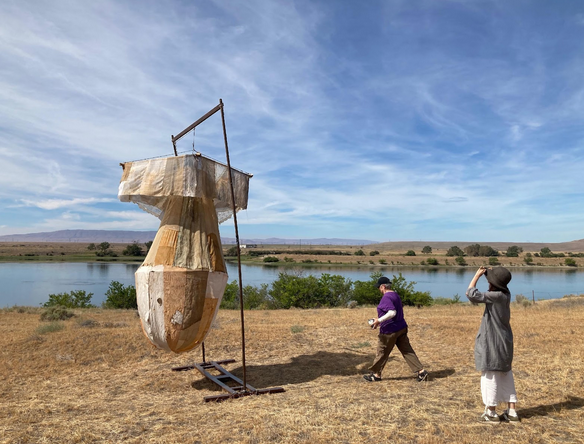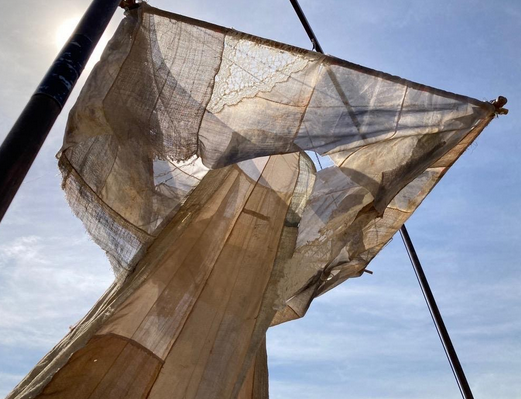Abstract: In August 2021, Yukiyo Kawano, a third generation Hiroshima hibakusha, was refused permission to install her sculptural evocation of the Nagasaki bombing, at the first commemoration of the atomic bombings within the National Park Service’s Manhattan Project National Historical Park at Hanford, Washington, where plutonium for the “Fat Man” device was produced. The artist nonetheless raised the piece near the restricted Hanford zone. We consider the work’s complex ritual symbolism and the Park’s resistance to interpreting the impact of nuclear weapons and the legacies of environmental toxicity associated with plutonium production at Hanford during WWII and the Cold War.
Keywords: Hibakusha, Nagasaki, Hiroshima, Art, Nuclear, Memorialization
On August 10, 2021, artist Yukiyo Kawano and a collaborator briefly erected her wire-framed silk sculpture “Fat Man,” modeled on the plutonium-based nuclear weapon that exploded over Nagasaki 76 years earlier in the world’s second nuclear attack. For about an hour, rippling in the wind, this solitary work stood on a stretch of wild land directly across the Columbia River from the Hanford nuclear reservation, where the plutonium used in the Nagakasi weapon was produced in 1944 and 1945 (Figure 1).This essay explores the layered meanings embedded in Kawano’s evocative art work, and the complex circumstances of her efforts to install the piece briefly at this fraught location.
Figure 1: Artist Yukiyo Kawano and collaborator Laura Feldman
installing Fat Man assemblage, Hanford Reach, August 10, 2021.
Credit: Irene Lusztig and Helki Frantzen
Our point of departure is an evocative passage in Kawano’s address at the National Park Service commemoration on August 9, 2021 of the Hiroshima-Nagasaki bombings, delivered in Richland the evening before she independently raised her artwork along the Columbia River. She spoke of her present day predicament as “dwelling on my falling,” as she reflected on the legacies of her grandfather, who had survived near the hypocenter of the Hiroshima detonation, having previously served in the Imperial Japanese Army in China. In what follows, we seek to unpack the varied nuances of “dwelling” in Kawano’s approach to history, memory, trauma, and the continuing struggle for historical accountability. How, through her artistic process, does she reside simultaneously in positions of being both victim and perpetrator, distant bystander and engaged witness? How does she dwell within an endlessly repeated moment of traumatic horror, as the bomb perpetually falls to earth, while also stepping outside of that moment to reflect on wider sweeps of history and moral responsibility?
Context and Background
Born and raised in Japan, Yukiyo Kawano received her MFA from Vermont College of Fine Art in 2012. Her MFA thesis paper grappled with the Japanese grammatical structure of 自動詞 (Jidōshi), intransitive verbs in which personal agency is obscured or displaced. Initially trained as a painter, she has increasingly worked in three dimensional sculptural forms, conceptual art, and multimedia installation genres, reflecting on the weight of historical trauma, especially in reference to the Asia-Pacific War and nuclear weapons. Her work has been exhibited in the United States, Japan, and Australia, including at Seattle’s Wing Luke Museum, Richland’s REACH Museum, the Tnadanya National Aboriginal Cultural Institute in Adelaide, and numerous college and university galleries.
In her artist’s statement, she notes, ““My work is a direct response to the tragedy of the past, but the past I depict wants to remember the present. People say my work is like a dream; it is not meant to deliver certainties. It asks us to remain in the present, so that we can develop a new relationship of mind and body, confront the ongoing deceptive rhetoric that surrounds us, reject violence, and save ourselves from our own extinction.”1
Over the past decade, Kawano has produced several works that seek, in her terms, to “remember the present,” through commemorating the first two nuclear weapons, used in the U.S. attacks on Japan in August 1945, in ways that engage with present-day social and environmental crisis (Ryan 2015). In 2019, she created a life size replica of the Fat Man nuclear device, detonated over Nagasaki, out of pages of the August 15, 1945 of the Oregonian newspaper, announcing the surrender of Japan. The piece was surrounded by paper lanterns used in the “From Hiroshima to Hope” floating lantern memorial, held in Seattle. This imagery recalls the internationally famous practice each year on the night of August 6 in Hiroshima, as lit lanterns float down the Motoyasu River, past the site of the hypocenter, where the “Little Boy” nuclear device exploded at 8:15 am, August 6, 1945. These rites are transformations of earlier floating paper lanterns used in Japanese Buddhist practice to memorialize the Dead, guiding the souls of the deceased on their cosmic journey.
Five of Kawanos’ facsimiles of weapons of mass destruction are created out of silk from her grandmother’s kimonos and are sewn together with strands of her own hair (Yukiyo Kawano: personal communication). All of her bomb replicas are depicted as falling towards the earth, their noses ominously pointed towards the ground; in contrast, she notes, to the standard depictions in US representations, which usually depict the bombs in a more neutral horizontal position, as if to emphasize the techno-scientific achievements of the Manhattan Project.
Figure 2: Artist assembling lower half Fat Man assemblage,
containing kimono panels.
Credit: Irene Lusztig and Helki Frantzen
The gentle, billowing textiles deployed in these replicas stand in marked contrast to the hard metallic casing of the actual nuclear devices (Fig. 2). It is possible that the artist’s choice of kimono as artistic medium is influenced in part by the famous image of cross-hatched scars, from the patterns of a summer kimono or yukata burned into the back of a Hiroshima A-bomb survivor.2 The artist’s use of her grandmother’s kimonos intimately connects her to her own family history of nuclear devastation, given that Kawano is the grandchild of a Hibakusha, or nuclear weapons victim. Her maternal grandfather, referenced above, was a former Imperial Japanese Army solider stationed in China, the Malay Peninsula, and Japan during the Asia-Pacific War, 1937-1945, and was in the basement of the Chūgoku Electric Power Company building, 800 meters from the hypocenter of the Hiroshima A-bomb detonation, at 8:15 am on August 6, 1945. He survived and then recovered outside of Hiroshima; he and his wife moved to Tokaichi-machi, near the present location of the Hiroshima Peace Memorial Park. Their daughter, Yukiyo Kawano’s mother, was born there in 1947; she and her older brother both perished of cancer nearly seven decades later, in the same year.
The artist’s use of her own hair, containing traces of her own DNA, highlights the intertwining of the living and the dead, a prominent motif in commentaries by Hibakusha. As she notes, the daily sight of her own hair in the shower inevitably calls to mind hair lost by Hibakusha to radiation exposure. She carries within each cell of her body the genetic legacies of her fore-parents, including her grandparents’ and parents’ generations, whose DNA was exposed to the bomb’s ionizing radiation and potentially altered.
Kawano explains that she disassembled her grandmother’s kimonos by unraveling the threads with which the garment’s silk panels were sewn together, a process that may have evoked or replicated the partial undoing of molecular genetic material caused by alpha and gamma
emitters, evoking afflictions that were perhaps epigenetically transmitted to subsequent generations. Her translucent bomb reenactments may be conceived of as quasi-ancestral beings, who mediate between cosmological domains of the visible and the invisible, between progenitors and descendants, between the absent and the present. Indeed, these vertical sculptures may emulate mountains, one of the most important mediating forms in Japanese ritual practice. Mountains in Japan are exemplary connectors between ontological realms, allowing for productive traffic between mortals, ancestors, and divinities and between terrestrial and celestial registers (Schattschneider 2003; Yamaguchi 1991). The sculptures may also recall the tsukuri-yama, or artificial mountains, erected at indigenous sites of veneration to modulate relations between humans and the kami (divinities). In contrast to the massiveness of actual mountains, which Yanagita Kunio argued are classically figured as domains of the Dead, Kawano’s assemblages are light-weight, filled with air, almost diaphanous, as if ready, like lit lanterns and spiritual offerings, to ascend gently into the heavens (Fig. 3)
More playfully, these textile works, created out of apparel, may evoke the familiar Japanese practice of drying laundry outdoors in sunlight. (Kimono panels are routinely disassembled for cleaning, and then dried outdoors.) The artist notes her own warm memories of women in the family hanging clean laundry outdoors, a quotidian form of labor undertaken for those whom one loves. In these hanging pieces, clothing items of a beloved matriarch are repurposed, so that they became not only sites of mourning, but expressive media of compassion, allowing artist and observer to co-participate in acts of care and affection, especially as the assemblages ripple gently in the breeze.
Figure 3: Lower section of Fat Man assemblage,
containing kimono panels.
Credit: Irene Lusztig and Helki Frantzen
Time Travel and Indigenous Presences
Kawano’s recreations of the bombs are displayed pointed downwards, as if they are falling towards earth moments before their detonation. In that sense the works open up the possibility of a kind of spectral time travel. They are forever falling, just before the cataclysmic instant of nuclear fission and fireball. They equally emulate the continuing environmental crisis at Hanford, where buried tanks containing 56 million gallons of radioactive liquids, the by-products or “daughter isotopes” of the plutonium production process, are slowly leaking their toxic contents into the earth, in vast plumes spreading towards underground aquifers and the adjacent Columbia River (Brown 2013). They remind us as well of a long history of settler colonial assault on indigenous lands, centered on the forced removal of Native peoples from the Hanford Reach region from 1943 onwards. Past, present, and future disasters are thus powerfully conjoined in the Nagasaki installation, alongside the very river whose waters served to cool the single-pass B Reactor, within which Fat Man’s plutonium core was produced.
Kawano’s late mother, whom she regards as her spiritual teacher, was Catholic, and the fin section of the Fat Man assemblage incorporates a lace veil worn in Catholic Mass from her home congregation (Fig. 4). The artist notes that the long history of violent suppression of Hidden Christians in Japan engendered in her a deep sympathy for oppressed and subaltern peoples everywhere, including indigenous peoples. She has been increasingly concerned with radioactive legacies of nuclear weapons production and testing for indigenous communities and sacred native lands. These include Navajo (Dine) uranium miners whose bodies and health were compromised through radiation exposure, and Tewa, Pueblos, Shoshone, and other native peoples and ancestral terrains contaminated near Los Alamos and Nevada above-ground nuclear test sites, from Trinity onwards. The Hanford nuclear reservation, she notes, was constructed on lands sacred to multiple native peoples for over 10,000 years, and has rendered parts of this landscape, in which are embedded the graves of countless indigenous ancestors, potentially uninhabitable for tens of thousands of years to come. In the fragile, translucent shape of her sculpture are bound together the fates of the Hiroshima and Nagasaki victims and survivors, those impacted by the Fukushima Dai-Ichi disaster, irradiated Native peoples and lands, and many other Downwinders subjected to ionizing radiation across the decades.
Figure 4: Upper (fin assemblage) part of Fat Man sculpture,
containing lace Catholic veil.
Credit: Irene Lusztig and Helki
Attempted Installation: August 9-10, 2021
Last year, Yukiyo Kawano learned that the National Park Service’s Manhattan Project National Historical Park was planning for the first time to hold a formal commemoration of the Hiroshima and Nagasaki nuclear attacks. The act establishing the park, covering the three sites of the Manhattan Project, Los Alamos, Oak Ridge, and Hanford, was signed into law by President Obama in December 2014 (Kelly 2015). For the first six years of its existence the Hanford section of the park studiously avoided direct public engagement with the historical fact of the deaths of hundreds of thousands of person as a result of the two wartime nuclear devices.
The commemoration was initially timed for the 75th anniversary of the bombings in 2020, but was delayed a year due to the COVID-19 pandemic. The artist proposed to the NPS site administrators at Hanford that her Nagasaki bomb replica, which had previously been displayed in the traveling exhibition “Particles on the Wall” (2017) at the REACH museum in Richland, about forty-five miles south of the B Reactor Hanford site, be publicly displayed at Hanford or in Richland as part of the memorial activities. Park leaders were initially welcoming of this proposal, but two weeks later permission was withdrawn, evidently after administrators looked more closely into the nature of Kawano’s work. The MP National Historical Park leadership insisted that the commemoration would be limited to participants walking along a path lit with 200 candle luminarias, ringing the “Peace Bell,” which had been sent to the city of Richland in 1985 by the mayor of Nagasaki, and a performance of the pentatonic choral piece, “Hiraita, Hiraita,” arranged by composer Ken Hakoda. (This folk Japanese lullaby about a lotus flower opening has no connection to Hibakusha or nuclear commemoration, but is sometimes celebrated in the West as evoking the mysteries of the East.)
Figure 5: The Fat Man assemblage, within the Hanford Reach National Monument
(White Bluffs North Trailhead), showing the work’s shadow in foreground.
Credit: Irene Lusztig and Helki Frantzen
It should be noted that the Hanford nuclear site is jointly managed through a complex joint agreement between the US Department of Energy (DOE), which is in part a successor of the Atomic Energy Commission, and the National Park Service. The DOE remains responsible for remediating nuclear contamination on the site, an enormously ambitious (and currently stalled) multibillion dollar enterprise (Niles 2014; Cram 2015; Auslander 2021). In principle, NPS has autonomy in interpretive matters, but in practice there is reason to think that DOE bears considerable influence over how the stories of nuclear weapons production are told and circulated within this historic site. To date, the primary emphasis in interpretation at Hanford has been on the “critical national security mission” of plutonium production at Hanford, during World War II and the Cold War, with virtually no acknowledgement of the tens of thousands of civilian casualties resulting from the Nagasaki nuclear attack.
At one point in the correspondence leading up to the August 2021 ceremony, a park official referred to Kawano’s work as “activist art.” The artist demurred, noting that her works carefully avoid explicit narrative frameworks, and are carefully designed to be open to a great range of interpretation. The park management was adamant and would not permit Kawano to install the piece as an official component of the commemorative events on August 9, 2021.
Kawano was allowed to speak briefly at the evening ceremony in Richland on August 9, 2021 in front of a small audience. She delivered the following address:
My name is Yukiyo Kawano. I was born and raised in Hiroshima, a third generation survivor of the U.S. atomic bomb.
A 3rd generation survivor —means it was my grandfather who was half a mile away from the detonation center on August 6th 1945. He survived the nuclear blast and found the way out.
Later, grandfather and grandmother had my mother Kuniko.
A 3rd generation survivor —means it was my daily routine (growing up) to check with my mother and see how she was feeling each morning.
It means I lost her to cancer in 2013 — 67 years after the U.S. Atomic bomb.
Today, I live and work in Portland, OR, creating visual art that is influenced by my personal and family history. I have been making life sized recreations of Little Boy and Fat Man, by stitching together inherited kimonos with my hair (of which I am planning to put up by the community center tomorrow night)
In making the piece, I imagine weaving the past and present, the human caused disaster that changed our world forever, and yet we continue “examining what is human.” Because that is the only way that protects us from the future.
Today, I am painfully aware that I spent my foundation years as a member of my country’s majority (Japanese). The financial success of the Asian nation enabled my countrymen to foster their perpetrator/colonizer mentality (while American occupation never really left Japan).
My perspective (and surviving Hiroshima/Nagasaki hibakushas at large) is a product of this fabricated and opaque history.
Then “reality check” hit me, called COVID-19. As the death rate rises, the existing/unsolved issues start to unfold. And each time an event reminds me of the racial indifference –I shared as part of my culture– I stumble and fall.
Dwelling on my falling is a process that leads me to a more unclouded place, where I will find myself to take risks. By confronting the horrors of the war and my family’s experience through my art, I ask myself a question as a granddaughter of a Japanese soldier who was deployed to China in 1937, the year of the Nanjing Massacre, and again in the Malay Peninsula in 1942.
Grandfather told me, when I was 10, that he won’t share his survivor story of the U.S. atomic bomb because he said there is no point to tell, that I can never understand him —Japanese violent history forever silenced him.
In 2020, in my dwelling on my falling—the voice of grandfather “in me” recognizes that: “I am in pain three generations later, the act of racism in the war hurts my soul and threatens my body”
My voice is no longer hidden, no longer abstract. “After three generations [of silence], I can finally say aloud that I’ve experienced the pain of my family’s past.
Figure 6. Preparing to take down the Fat Man assemblage,
within the Hanford Reach National Monument (White Bluffs North Trailhead)
Credit: Irene Lusztig and Helki Frantzen
Unfortunately, this moving testimony is missing from the NPS official video record of the event, although the artist is shown speaking. (A park leader later informed her that the videographer’s microphone had not been able to capture her words.)
Since the NPS had not allowed her to install the Fat Man piece, the artist decided to take independent action. The morning after the commemorative events in Richland, she travelled with peace educator Laura Feldman and filmmakers Irene Lusztig and Helki Frantzen into the Hanford Reach National Monument, a wildlife refugee that, unlike the Hanford nuclear reservation, is open to members of the public without access restrictions. The monument landscape is a relatively pristine exemplar of the arid “shrub steppe” ecosystem of the interior Northwest, that preceded the introduction of commercial agriculture, irrigation, and industrial development in the region. The group decided raise the the art work off of the White Bluffs North Trailhead, within the Hanford Reach National Monument, which falls under the authority of the US Fish and Wildlife Service and not under the National Park Service; thus, the Manhattan Project National Historic Park could not legally prevent the installation.
The team raised a scaffold frame and mounted the “tail fin” and main “bomb” assemblages of the Fat Man replica, so that its nose pointed down towards the earth and its tail fins rose towards the sky. The ten foot high erect sculpture towered over the low sagebrush and other small flora of the shrub steppe, billowing gently in the breeze. The muted colors of the fabric, sourced from the artist’s grandmother’s kimonos, nearly matched the brown soil of the land. In the distance, across the blue expanse of the Columbia, the team could glimpse the old high school in the abandoned town of White Bluffs, cleared of population in 1943 to make way for the secret Hanford Site. Beyond this are located the nine reactors and industrial facilities of Hanford, in various states of cocooning, mothballing, and disassembly.
The Fat Man form cast an enigmatic shadow on the earth, reminding some observers of the permanent shadows etched on the Hiroshima and Nagasaki cityscapes 76 years earlier (Fig. 5)
After an hour, as the wind speed picked up, the group lowered the sculpture, packed it up, and returned to Richland (Fig. 6).
That evening, Kawano participated in an annual Nagasaki commemoration ceremony, organized each year by peace and civil rights activist Jim Stoffels, a retired physicist who has lived in Richland since 1962. (The ceremony usually takes place on August 9, but in 2021 it was delayed one day to allow for the NPS event.) In her brief remarks, Kawano noted that given the extensive culture of denial around Hanford, including the long history of violence against indigenous Yakama, Wanapum, and Umatilla peoples, she did not feel that reconciliation was yet possible. Reconciliation after all requires acknowledgement, and neither the National Park Service nor the Tri-city leadership (of Richland, Kennewick, and Pasco) has fully acknowledged the true costs of the Manhattan Project and its Cold War legacies. She brought greetings from the mothers group of activists in Fukushima, who expressed their concern for the residents of the Tri-city region.
The Riverside Installation: Concluding Thoughts
The Fat Man piece, first and foremost, can be approached as a memorial offering to the victims of nuclear blast and associated ionizing radiation exposure at Hiroshima and Nagasaki. Pondering Kawano’s deployment of her grandmother’s kimono fabric, we are reminded of varied objects used in the Japanese Buddhist memorial practices of kuyō, including textiles wrapped around stone statues of the bodhisattva Jizo (lit. womb of the earth), a guardian of children and of travelers, who aids the dead in their journeys towards Buddha-hood. Jizo in especially associated with the mythic terrain of the “Sainokawara,” the underworld banks of the river Sai, where the souls of dead children are comforted by this sacred being’s infinite compassion. (Yanagita Kunio (1970) proposes this river bank imagery is grounded in pre-Buddhist indigenous cosmology.) Along the banks of the Columbia River, Kawano’s textile bomb-like assemblage may similarly offer succor and refuge to countless souls who perished in nuclear fire or who subsequently suffered from radiation-induced illness.
In this light, let us return to Kawano’s reference in her August 9, 2021 address, delivered the night before raising the Fat Man replica on Hanford Reach, to “dwelling on my falling.” Manifestly, this phrase references her growing realization of her historical position in the privileged Japan-US postwar alliance, which interpolates her into an extended history of settler colonialism and capitalist domination in the Asia-Pacific region. She has become, she notes, increasingly conscious of how she “stumbles and falls,” in the process of acknowledging her own historical complicity, and thus she comes to dwell in this space of “falling.” Through this polyvalent work of art she partially merges with her grandfather, who served in the wartime Japanese Imperial Army, and was thus implicated in its acts of terror against diverse East and South-east Asian peoples, even as he was himself victimized, along with his family, by the US nuclear attack on Hiroshima. In a more nuanced sense, “dwelling while falling” also characterizes her visceral engagement with the bomb sculpture itself, which, as noted above, can be read as perpetually falling towards earth, towards the critical instant of fission and explosion. The installation of the work, just across the river from the restricted Hanford zone, invites us all to dwell on and dwell within this mythic space of free fall. In so doing, we join with the artist in “dwelling” within the ethical position of falling, perpetually failing, in effect, to reach a state of true compassion and atonement for the historical failings of both Japan and the United States (Fig. 7).
For the hour that the work was raised across the river from the Hanford nuclear reservation, it stood as a silent witness to the culture of disavowal, denial, and liability-aversion that still haunts US official reckoning with the vast human costs of the Manhattan Project and the continuing legacies of nuclear weapons production. The National Park Service has been at the forefront of many of the most challenging memory projects in the modern American historical landscape, including curating and interpreting sites and memorial traces of slavery, post-slavery racial apartheid, lynching, genocidal violence against Native Americans, and the wartime internment of Japanese-Americans. Yet for some reason, the institution still seems paralyzed in the face of the shadows of Hiroshima and Nagasaki and the environmental violence of Cold War uranium extraction, plutonium production, and nuclear testing. As of this writing, the Manhattan Project National Historic Park leadership seems incapable of challenging the dominant military-industrial narrative that the atomic bombs were a triumph of wartime technocratic achievement, and that Hanford’s reactors helped to “win” World War II and the Cold War. In the absence of courageous vision from the Park, it falls to artists such as Yukiyo Kawano to hold aloft a lantern of conscience, along the banks of an ancient riverscape.
Figure 7. Upper section (tail fin assembly) of the Fat Man sculpture,
within the Hanford Reach National Monument.
Credit: Irene Lusztig and Helki Frantzen
Acknowledgements: The authors are deeply grateful to Yukiyo Kawano for generously sharing her reflections on the meaning of her sculptural works, and to Asato Ikeda and Jordan Sand for their thoughtful commentaries on an earlier version of this essay. Irene Lusztig and Helki Frantzen generously allowed their photographs of the Fat Man installation at Hanford Reach to be reproduced. Kawano’s installation will be documented in Lusztig’s forthcoming feature length nonfiction film “Richland,” exploring the intertwined histories of the Hanford nuclear site and the city of Richland.
References:
Auslander, Mark. 2021. “Long Exposures: Traveling along Glenna Cole Allee’s Hanford Reach.” in Hanford Reach: In the Atomic Field. Daylight Books.
Brown, Kate. 2013. Plutopia: nuclear families, atomic cities, and the great Soviet and American plutonium disasters. Oxford: Oxford University Press.
Cram, Shannon. 2015. Becoming Jane: The making and unmaking of Hanford’s nuclear body
Environment and Planning D: Society and Space (August 24, 2015)
Kelly, Cynthia C. “The Making of the Manhattan Project Park. Federation of American Scientists. Public Interest Report. Winter 2015. Volume 68 (1)
Niles, Ken. 2014. “The Hanford cleanup: What’s taking so long?” The Bulletin of Atomic Scientists. (July 1, 2014 )
Rand, Robert. 2017. Mrs. Herskovitz’s Kimono. Tablet. August 3, 2017.
Ryan, Rosanna. 2015. Art from Hiroshima, Maralinga explores legacy of the atomic age. Australian Broadcasting Corporation Radio National. 5 August 2015.
Schattschneider, Ellen. 2003. Immortal Wishes: Labor and Transcendence on a Japanese Sacred Mountain. Durham: Duke Univeristy Press.
Yamaguchi, Masao. 1991. The poetics of exhibition in Japanese culture. in Exhibiting cultures : the poetics and politics of museum display. Ivan Karp and Steven Lavine, eds. 57-67. Washington: Smithsonian Institution Press.
Yanagita, Kunio. 1970. About our ancestors: Japanese family system. Translated by Fanny Hagin Mayer and Ishiwara Yasuyo. (Japanese National Commission for UNESCO). Tokyo: Japan Society for the Promotion of Science.
Notes
Robert Rand (2017) details his quest to identify the young woman documented in this widely circulated photograph.



